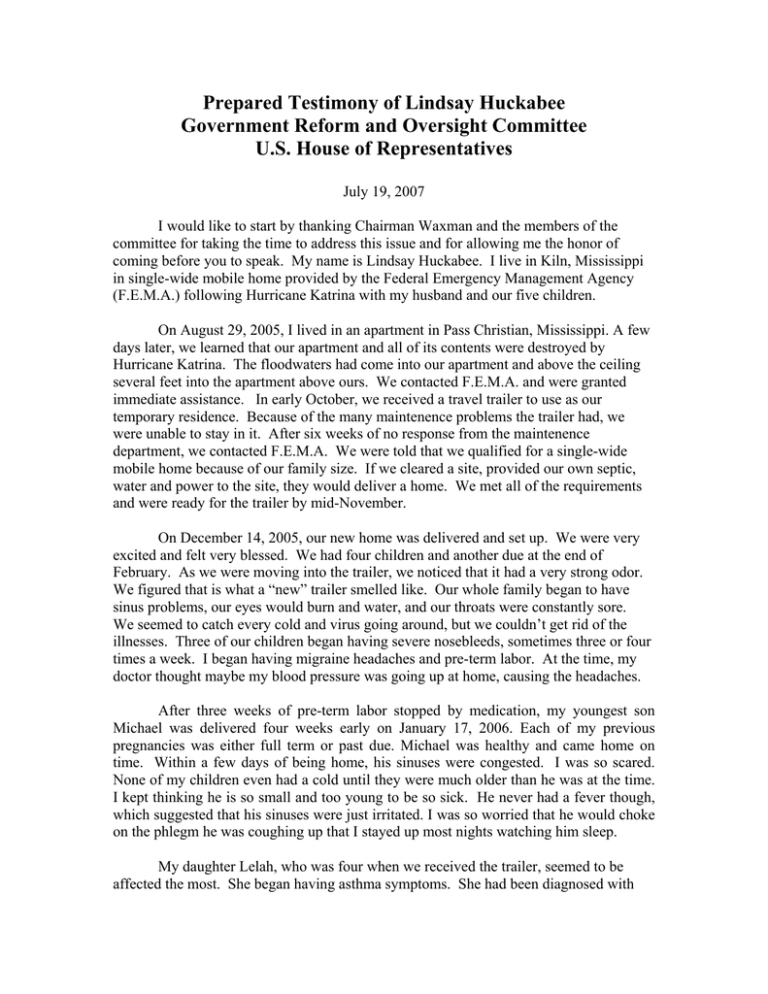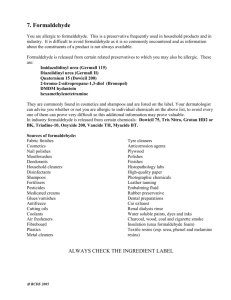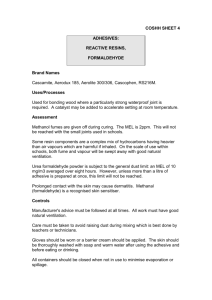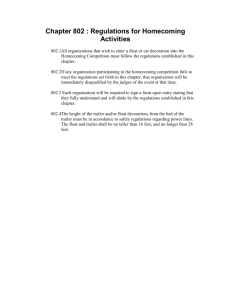Prepared Testimony of Lindsay Huckabee Government Reform and Oversight Committee
advertisement

Prepared Testimony of Lindsay Huckabee Government Reform and Oversight Committee U.S. House of Representatives July 19, 2007 I would like to start by thanking Chairman Waxman and the members of the committee for taking the time to address this issue and for allowing me the honor of coming before you to speak. My name is Lindsay Huckabee. I live in Kiln, Mississippi in single-wide mobile home provided by the Federal Emergency Management Agency (F.E.M.A.) following Hurricane Katrina with my husband and our five children. On August 29, 2005, I lived in an apartment in Pass Christian, Mississippi. A few days later, we learned that our apartment and all of its contents were destroyed by Hurricane Katrina. The floodwaters had come into our apartment and above the ceiling several feet into the apartment above ours. We contacted F.E.M.A. and were granted immediate assistance. In early October, we received a travel trailer to use as our temporary residence. Because of the many maintenence problems the trailer had, we were unable to stay in it. After six weeks of no response from the maintenence department, we contacted F.E.M.A. We were told that we qualified for a single-wide mobile home because of our family size. If we cleared a site, provided our own septic, water and power to the site, they would deliver a home. We met all of the requirements and were ready for the trailer by mid-November. On December 14, 2005, our new home was delivered and set up. We were very excited and felt very blessed. We had four children and another due at the end of February. As we were moving into the trailer, we noticed that it had a very strong odor. We figured that is what a “new” trailer smelled like. Our whole family began to have sinus problems, our eyes would burn and water, and our throats were constantly sore. We seemed to catch every cold and virus going around, but we couldn’t get rid of the illnesses. Three of our children began having severe nosebleeds, sometimes three or four times a week. I began having migraine headaches and pre-term labor. At the time, my doctor thought maybe my blood pressure was going up at home, causing the headaches. After three weeks of pre-term labor stopped by medication, my youngest son Michael was delivered four weeks early on January 17, 2006. Each of my previous pregnancies was either full term or past due. Michael was healthy and came home on time. Within a few days of being home, his sinuses were congested. I was so scared. None of my children even had a cold until they were much older than he was at the time. I kept thinking he is so small and too young to be so sick. He never had a fever though, which suggested that his sinuses were just irritated. I was so worried that he would choke on the phlegm he was coughing up that I stayed up most nights watching him sleep. My daughter Lelah, who was four when we received the trailer, seemed to be affected the most. She began having asthma symptoms. She had been diagnosed with asthma when she was about one, but had been symptom free for about a year. Just prior to moving into the mobile home, I discussed with her doctor the possibility that she had outgrown the asthma when we went in to see him for her four-year-old checkup. Over the next 18 months, Lelah had more ear infections than I can count, nosebleeds several times a month, sometimes as many as a three a week. She had pneumonia several times. For most of the cases, she was treated at home with steroids and breathing treatments, but she had to be hospitalized twice because the pneumonia was so severe. Lelah was sent to an E.N.T., where she underwent allergy testing, an M.R.I., and surgery to put tubes in her ears so that the excess fluid her sinuses were producing had a place to escape. She was put on different allergy medications, steroids, and nasal sprays to try and ease her symptoms. Nothing worked. I was told by our E.N.T. that we needed to get out of the trailer as soon as we could. He had many repeat patients with the same symptoms all living in F.E.M.A. trailers. He said that there were chemicals that could be making Lelah sick. We took Lelah to an Allergy and Asthma specialist. He did another allergy test and found nothing. I never thought I would be upset to hear that nothing was wrong with my child after a test. If there were an allergy, then at least we would know what to fight. He did say that her asthma was not as under control as I thought it was. Her coughing in the middle of the night and the constant “cold” she kept needed to be closely monitored. He said that she obviously had a constant exposure to some sort of irritant. Then he asked if we were in a F.E.M.A. trailer. He too had seen an increase of patients with inactive or mild asthma having more severe problems upon moving into these trailers. After putting Lelah on inhaled steroids twice a day, a daily allergy medication, and an oral steroid if she starts to get a cold, we have her asthma “under control.” Lelah missed 42 days of kindergarten this year. All but three of these were because of doctor visits or asthma systems. The school nurse called me to get her from school several times because of nosebleeds and fevers. Looking back, she would have been better off spending more time at school rather than being sent home. We were taking a sick child and making her spend more time in the place that made her sick. After months and months of office visits and phone calls, I was frustrated and upset. I came home one afternoon to find my daughter covering her nose; her hands, arms and shirt were covered in blood. The surprising part is that I did not feel the need to rush to her and find out what was wrong. I did not think for a second that it was anything more than a bloody nose. Two years ago, I would have panicked trying to get to her. Later that night, I cried for hours. How had we gotten to the point where I was not surprised to see my child covered in blood? I asked my doctor what I was doing wrong. Why couldn’t I get my kids healthy and keep them that way? I had always been one of those moms who wouldn’t bother the doctor with a low-grade fever or a cold that didn’t last more than a week. Before moving into the F.E.M.A. trailer, I can’t remember going to the doctor other than for well-child checks and a few times with Lelah when she was very young for treatment of her asthma. Suddenly I was at the doctor’s office or calling him just about every week. The receptionist knew me by my first name, and I swear she probably knew my voice, too. Our Pediatric doctor had told me that there seemed to be a trend among patients in F.E.M.A. trailers and increased office visits with allergy-like symptoms. It was through him that a Sierra Club member contacted me about a formaldehyde test to see if we were living in levels that could be dangerous. I really did not want this to be the answer, since we had nowhere else to go. We finally had a Formaldehyde test done on our trailer in April of 2007. It came back as 0.18ppm.-well above the 0.10ppm believed to be harmful to humans. There is no way to know how high it was in the 16 months we lived in the trailer. Since F.E.M.A. suggested that “opening windows would out-gas the fumes and lower the level”, I have to believe that the level was much higher when we moved in. When we told F.E.M.A. about the test, we met much opposition. F.E.M.A. representatives were rude when I called them. I was forced to call more than 5 different representatives, and my request for a new mobile home was lost twice before anything was done to help solve my problem. Finally, F.E.M.A. agreed to replace our mobile home. We packed up our stuff and put it in storage. We stayed with family for the week it took to switch the trailers out. We were told that the new trailer would be “formaldehyde free”. It was a used trailer built in 2005 by a different company. We had a formaldehyde test done on it before we started to move anything into it. An inspector from F.E.M.A. saw the tester hanging and asked what it was. When I told him it was used to test for formaldehyde, he said that people were claiming to have high formaldehyde levels so they could get bigger and better trailers. When I asked if F.E.M.A. had done tests to find this out, he said NO. The test on the new trailer came back at 0.108ppm which is still above the level believed to be harmful, but lower than the last trailer. When we called F.E.M.A. to tell them what the results were, the lady said, “so we are good, right?” Three weeks ago my husband was having his teeth cleaned when the dentist found a mass in his soft palette. He was referred to an ENT to have it examined. He had a CT scan followed by surgery to remove the mass, which they discovered was a Polymorphic Adenoma tumor. My husband is a healthy, 30-year-old non-smoker. His tumor was a common type, but in a very rare location. When I brought up our recent formaldehyde test, the ENT asked my husband if he breathes through his mouth which he sometimes does. While no one can say for certain that the formaldehyde caused this kind of mouth tumor, the ENT said that he will definitely make note of it for possible future study. It is known, however, that formaldehyde puts people at an increased risk for nasal and lung cancer. Mouth tumors could be another long-term effect of people living with the high concentrations of formaldehyde. What makes me so angry is that F.E.M.A. is providing trailers to disaster victims that they have “inspected” and deemed safe without truly ensuring that they are. F.E.M.A. does not run air quality tests on the homes they provide; my air quality test was done at the expense of the Sierra Club. I have heard there is a pamphlet that was given to people by F.E.M.A. about formaldehyde, but I never received one, not even with the second trailer. If it had not been for my family’s medical problems, I would not have known about the formaldehyde problem. I am scared to think of how many other families are being exposed to high levels of formaldehyde and will have medical problems in the future. What scares me even more is the knowledge that the level of 0.1ppm, the maximum recommended exposure limit, was not intended to gauge how safe exposure was for children, people with breathing problems, or even healthy adults for longer than the average eight hour workday. No one can tell us what to expect long-term from this exposure. I do not want to believe that F.E.M.A. knew about the formaldehyde when they issued these homes, but I do know that when it was brought to their attention, they spent little effort to fix the problem. Instead, people were made to feel that they were being too picky, or looking to blame someone else for simple colds and normal problems. If you take each individual and their symptoms, they appear to be no big deal. I think this make formaldehyde even more dangerous. When F.E.M.A. took on the role of landlord for the thousands of people, they took on the responsibility to provide a safe, fit home for these people. This temporary housing should have given people time to get on their feet again, and even save some money for a permanent home. Instead we are spending so much on medical bills and prescriptions, we are actually moving backwards. Thank you very much for taking the time to read my testimony and to deal with this very important issue.






